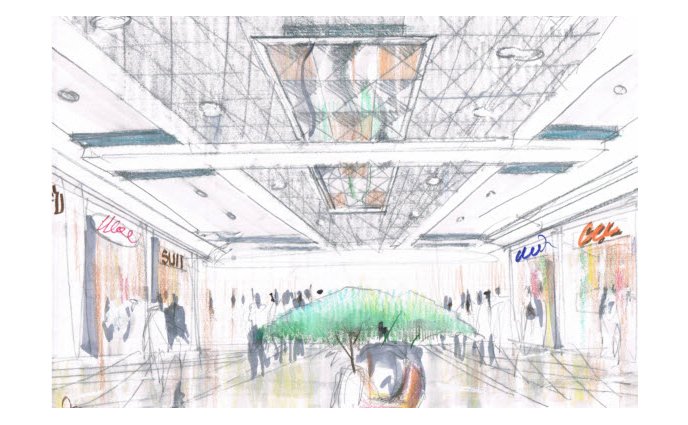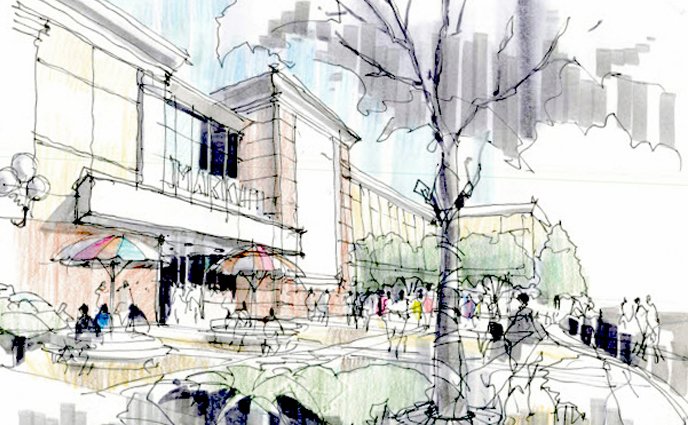Sketches and text by Issam (Sam) A. Shukor
Architect, OAA, AIBC, AAA
This post is part of our summer 2018 blOAAg series, Summer Sketches: Capturing the Essence of Architectural Ideas.
I cannot imagine my architectural career without sketching. Sketching is at the heart of the process of creating architecture. I call these processes iterations. Iterations are the architect’s virtual honing of the architectural form “safely” on paper. We keep doing so until the form finally surrenders and answers the particulars of the design problem.
For me, sketching is not just an expression of an image that is created in the mind, but more precisely it is an expression of the interactions between the mind and the hand. Before I hold my pen to sketch, I make sure that my mind is focused on the design problem particulars (program), site info, functions, images, previous examples, art works, colors and atmospheres, such that when I hold the pen, the interactions become powerful and meaningful.

Left: Interior Design of an existing office building’s lobby. The curved balcony appears more dynamic in the sketch.
The sketch also focused on texture rather than materials at this point. (Ink on sketching paper).
Right: A 10-second study sketch of a strip plaza. This sketch tackles my favorite issues in retail architecture: scale, solving the “loci” problem (i.e. creating a place not objects - a subconscious theme that keeps emerging in my sketches, defining entrances, providing thematic advertising for retailers, and, fluidity of mass.
These issues can not be finalized without a series of sketches.
(Felt tip on writing paper).

This sketch is a study of a retail kiosk and suspended GWB ceiling as a feature or motif across a mall.
The sketch attempts at focusing attention on the ceiling motif through form and color.
(Ink, pantone markers, 2H pencil and colored pencil on writing paper).
Good sketching is not scribbling. Good sketching is the ability of the hand to manifest a very mysterious thing we hold dear to our hearts (as architects) called “the concept”. The architectural concept is abstract in nature. It is the most challenging thing that any architect could face. The concept only resides in the mind. The hand-sketch then becomes a manifestation of the concept. The first manifestation however is always the most genuine. There is a “spirit” in that first sketch that I always find challenging to maintain.
As for the client, the sketch bears a different meaning. For them, the sketch means the potential or the dream. For many of my clients, the sketch looks more genuine and filled with potentials. But its not only that. The sketch gives the client the chance to be a partner in the design process. A sketch can be critiqued much more effectively by the client (and less offensively) than when they do to a rigid photo-realistic 3D rendering. This back and forth process means engaged clients. Engaged clients are excited and confident. Sketching is not the only way to achieve that, but it’s a great way.

A sketch is also an effective tool to solve daily design issues and help make decisions before or during construction.
The aim here is to study a bulkhead issue. (Pencil and colored pencils on heavy velum).



Above three sketches: Markville mall façade complete retrofit schematic design. These sketches attempt to go beyond the “face-lift and rejuvenation of the mall appearance. They attempt to suggest more than that to engage the building on the urban planning level. Greenery, benches, shading umbrellas and seating areas were suggested. As one project managers said in the meeting “these sketches have life”. Architects: Petroff Partnership Architects, designer: Issam (Sam) Shukor.
(Ink, markers, colored pencils on tracing paper).
Finally, sketching for me is not about creating beautiful facades or well articulated masses and details, it is mainly about crafting spaces. Spaces for the activities of people (sorry but I never like to use the words “users, end-users, tax payers, energy consumers” and so on!), and of the opportunities it generates and of the charges it emanates. What you’re going to see here is mostly sketches of carved out spaces (even though the subject matter is solid pieces of architecture).

Left: Westmount shopping centre schematic design. Restaurant is to be built on a very large parking lot strip plaza with Cineplex movie theatre at the back-drop. The visual simulation and feel of containment was the main purpose in this sketch using simple lines. Architects: Petroff Partnership Architects, Design in Chief: Issam (Sam) Shukor. (Ink pen on paper).
Right: Schematic design of a mall. A mega structure was covering an existing traditional building in downtown Toronto.
The building became an internal focal point. (Felt tip on sketching paper).

Left: This is a sketch of a villa on a top of a hill. This sketch shows the entrance lobby which was built to be fully glazed as the surrounding views were too spectacular to hide. A stark contract of materials (glass and stone) were used to reflect the purity of a rugged landscape and a modernist approach. (Medium felt tip on sketching paper with colored pencils).
Right: A strip plaza with a beacon. The concept here is not the “weired sky” but in fact the corner which was meant to be a mixture of traditional element, modern composition, and playfulness to reflect the “Italian” name of the plaza: Piazza Del Sol. The sky was shown only over that corner. (Ink pen, colored pencils, and grey marker on velum).

Left: A massing study of Markville mall existing entrance remodelling. The deep shadows and lack of any details is intentional as this would be the first step to resolve. (Ink on translucent paper with grey and black markers and hints of coloured pencils).
Right: A study of mall entrance reconfiguration (renovation of existing mall.
(Ink on sketching paper with grey and black markers and a hints of coloured pencils).

The colossus movie theatre interior design of the middle concession area and glazed cladding system at the front entrance. The theme of the movie theatre was suggested to be a UFO landing in Vaughan and “aliens” would come down from the space ship. The motif dominated the interior design themes. The Cinmea streets followed different criteria. In this sketch the concept is to capture the concept working with the structural huge column in the middle was was divided to be a structure of columns supporting the “space ship” this column had been successfully concealed and the space was comfortably devoid of any “obvious” structural elements and the focus was made to be on the concession are and the bar above it.
Architects: Page & Steele Architects, Design in Chief: Issam (Sam) Shukor, under Principal Architect Mr. Robin Clarke.
(Ink, marker, and colored pencils on sketching paper).
Regardless of how you look at sketching or its meaning or purpose for your architectural development or business, I’d like to give one advice: never ever discard your first sketch. As the spark of ingenuity is always there.